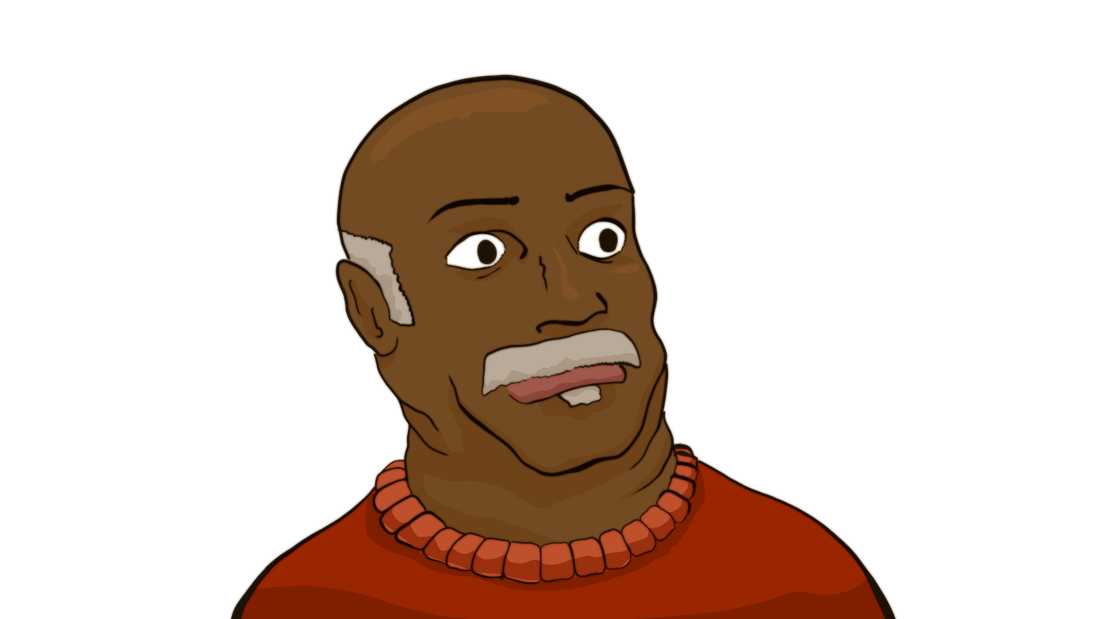|
https://globalgamejam.org/2019/games/my-neighbour-vampire
More than 46,000 people in 114 countries got together to make games this weekend. I was one of them. Over the past 9 years I have joined up with teams and filled all different rolls. I have made 3D models, painted textures, drawn concepts, and programmed game features. I think this is the first time I only focused on one task. This year I drew and painted portraits. The game we made is a visual novel style jokey adventure story. It required a lot of writing and a number of characters. My job was drawing images of the weird cast of characters in the script. I decided to attempt a cartoony line art and flat color style. This is not the way that I usually work and a very different style that I'm not very comfortable with, but that is the joy of the Global Game Jam for me. The time pressure is high (you only have 48 hours), but the stakes are very low (failing is part of the process), so you might as well try something new. You don't really have time to overthink it. I started out by heavily overthinking it, which meant the first character I made isn't very good. The second character is literally a palette swap of the first, but that is a joke in the script. After I got that out of my system and just started drawing oddballs everything went much smoother. All in all, it was a fun, relatively stress free weekend, and I added a few new tools to my arsenal. Here are the characters I made, but I think they work better with the dialog, so you should probably download the game and play through it a couple of times. It's fairly short, but it includes some randomization and a lot of branching paths to follow. Thank you to the team that built My Neighbour the Vampire. Sean Brown, Stephen Ma, Evan Kawa, Alex Bymoen, and Sarah Cline.
0 Comments
Still going here. I sort of bounced around and broke some stuff and then left the end pretty busted too. Sometimes you need to write really loose and bad for a bit and then put it back together later. Hopefully.
A small amount of movement over here. I was getting hung up on a scene so I jumped ahead and wrote some of the stuff after it. That leaves a big 'write this here' hole so I only included all the new stuff that actually makes sense to the continuity. As always, I have to issue this warning. This is an in progress rough draft of something that will likely be novella length. If you have ever wanted to read and comment on a story while it's being written, please be my guest. If you would rather wait until I have something that works from end to end and I have done at least some polish work on it, stay tuned and I will let you know.
Best Games - Marble Madness Marble Madness is a game that probably shouldn’t exist. I mean, obviously it does. People made it. The odds are pretty good Mark Cerny and Bob Flanagan made it sometime before it’s release, in 1984. At least that is what history says. Even playing it today, it’s hard to imagine some form of time travel wasn’t involved. I invite you to survey the landscape of video games in 1984. A lot of really great games were created or released that year. Tetris, Excitebike, Elite, 1942, King’s Quest; true classics. But no game in 1984 compares to the technical wizardry of Marble Madness. Until the advent of full 3d game engines and physics systems a decade later, nothing even came close. In most ways, Marble Madness is 1984 as hell. We were only 2 years off of Tron and hot on the heels of The Adventures of Andre and Wally B., a short film by an offshoot Lucasfilm division that would later become PIXAR. Smooth, shiny CG graphics and topographical grids had never been more in fashion. Limitations of the time meant the the graphics in Marble madness had to be composed of chunky pixels, but they certainly did all they could to feel like that glossy rendered CG stuff. It is the movement that really sets Marble Madness apart from its contemporaries. The trackball controlled marble on the screen moves like something from the future. It’s future. Our past. Listen, I’m not a time traveller so I don’t know how this stuff works, but I do know that Marble Madness controls and moves like nothing else of it’s era. The marble travels with a weight and accuracy that you can feel when you play it. Counteracting the momentum of a steep requires a natural, instinctive series of inputs. Small touches on the trackball connect you to the on screen world in a very physical way. Ports of the game would go on to use gamepads and joysticks slightly muting the effect of controlling a rolling marble, but somehow the feeling of accurate physical movement still holds on most platforms. Probably an artifact of whatever future tech was used to concoct the game. In many ways Marble Madness falls short as a game. It is not very long and ramps up the difficulty from flat to vertical wall in about 60 seconds. Sometimes the orthographic view angle makes it difficult to tell where things are in the levels. On the other hand, the music is absolutely bangin. So, I was wrong before, this game is actually fantastic. If you’re looking for a taste of the future, well the future from the perspective of 1984, you should probably play Marble Madness. It’s one of the best games. |
Archives
February 2024
Categories |
Owen McManus











 RSS Feed
RSS Feed